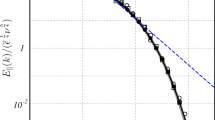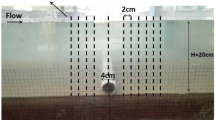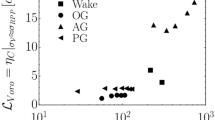Abstract
Compared to the classical two-dimensional plane mixing layer, the mixing layer between non-parallel streams has an additional degree of freedom: the angle between the streams and the direction perpendicular to the trailing edge. Consequently the mean vorticity vector, which depends on these angles, is no longer by necessity parallel to the trailing edge of the flow. The ensuing coherent structures are generally helices with components normal to the trailing edge. They can be controlled by different mechanisms, depending on the velocity vectors.
Similar content being viewed by others
References
Hackett, J. E., Cox, D. K.: The Three-Dimensional Mixing Layer between two Grazing Perpendicular Streams. J. Fluid Mech. 43, 1970
Liepmann, M. W., Laufer, J.: Investigation of free turbulent mixing. NACA TN No. 1257, 1947
Schumm, M.: Experimente zum Problem der absoluten Instabilität im Nachlauf zweidimensionaler stumpfer Körper. Dissertation, Technische Universität Berlin, 1991
Author information
Authors and Affiliations
Rights and permissions
About this article
Cite this article
Gründel, H., Fiedler, H.E. The mixing layer between non-parallel streams. Appl. Sci. Res. 51, 167–171 (1993). https://doi.org/10.1007/BF01082532
Issue Date:
DOI: https://doi.org/10.1007/BF01082532




